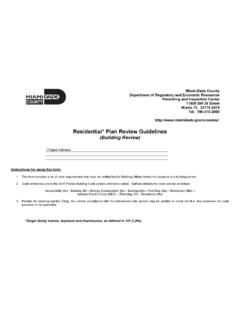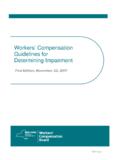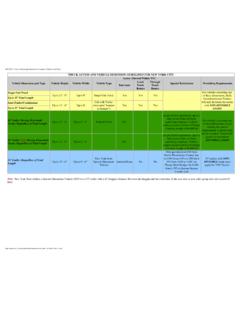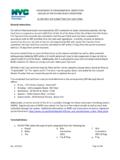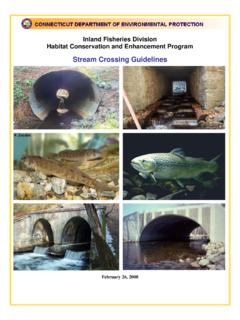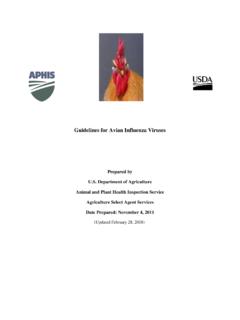Transcription of Chinese Drywall Remediation Repair Guidelines - www ...
1 Original: 9-13-09 Revised: 4-28-10 Certified Mold & Allergen Free Corp. This document is in the public domain and may be copied and/or modified. These Guidelines are in Draft format and are made available as a public service for use by qualified Environmental Consultants only. These Repair Guidelines may not be suitable for your specific requirements. These Guidelines are for the cleaning and removal of building materials in unfurnished homes. Guidelines are subject to change as more information regarding this topic becomes available. Use these Draft Repair Guidelines at your own risk. PROBLEM Chinese Drywall Remediation Repair Guidelines (CDW Remediation PROTOCOL) Introduction Homeowners in several states have reported unpleasant odors; occupant irritation; tarnishing of copper and silver materials; as well as high rates of HVAC coil failures.
2 These problems appear to be the result of the release of reactive sulfur gases from problem/corrosive Chinese Drywall . The goal of these Chinese Drywall Remediation Repair Guidelines ( Repair Guidelines ) is to clean or remove building materials affected by the presence of problem/corrosive Chinese Drywall and to restore the home in a manner to assure that there are no further Chinese Drywall related odors or detectable emissions/ corrosive gases or home owner irritation. These Repair Guidelines are designed to achieve this goal; however, they are not meant to exclude other similarly effective methods and should be supplemented by a site-specific work plan based on the nature of the construction methods used in the jurisdiction in which the home is located.
3 Task Force Recommendation According to the Federal Chinese Drywall Task Force (Task Force) recommendations released 4-2-10, homes do not need to be gutted down to the block walls in order to provide safe, healthy living environments. The Task Force found no health or safety reasons to remove non-problem Drywall , AC units, insulation, plumbing, or ducting. The Task Force recommends that in addition to removing problem Drywall , the following 3 items must be removed and replaced with new even if there is no indication of damage: 1. All fire safety alarm devices (including smoke alarms and carbon monoxide alarms); 2. All electrical components and wiring (including outlets, switches and circuit breakers); and 3.
4 All gas service piping and fire suppression sprinkler systems. Goals The goal of Chinese Drywall Remediation Repair Guidelines ( Repair Guidelines ) is to meet all Task Force recommendations plus Eliminate any evidence of prior problems that could negatively impact a home s resale value . Which means clean or replace visibly tarnished copper plumbing or HVAC equipment and replace any tarnished mirrors. As a result these Repair Guidelines will: Permanently eliminate all detectable odors. Permanently eliminate all problems associated with Chinese Drywall corrosive gas emissions. Permanently eliminate any occupant irritation that may be caused by Chinese Drywall corrosive gas emissions. Chinese Drywall Remediation Repair Guidelines This document is in the public domain and may be copied and/or modified.
5 - 2 - Eliminate any evidence of prior problems that could negatively impact a home s resale value. Restore the home to a safe living environment. Repair Guidelines Our Problem Chinese Drywall Remediation Repair Guidelines ( Repair Guidelines ) provides a practical approach to remove and replace the problem Chinese following Task Force recommendations. There is no one-size-fits-all Chinese Drywall Remediation protocol. Therefore we make an MS Word Doc version of these Repair Guidelines available at that can be modified by qualified Environmental Consultants to meet specific client needs. These Repair Guidelines are intended for use by those who will be undertaking repairs to: (1) detached, single-family homes, and (2) attached multi-family dwellings that are three stories or less (whether fee simple or condominium) and are constructed such that each distinct dwelling unit is separated vertically from adjacent units by a concrete masonry unit party wall.
6 All homes with problem Chinese Drywall also have some good Drywall . The good Drywall does not have to be removed in order to meet the requirements to restore homes to safe and healthy living environments. Our Repair Guidelines recommend removal of only the problem Drywall so long as the problem Drywall can be adequately identified as such. Otherwise remove all Drywall . Adequate testing that can pinpoint the problem and non-problem Drywall can often significantly reduce the cost of Remediation by reducing the amount of Drywall that needs to be removed. See Chinese Drywall Assessment 101 at for more information on assessing Chinese Drywall . Note that not all brands of Chinese Drywall are problematic.
7 There are claims that some US made (synthetic) Drywall may be problematic although we have not seen any US Drywall that meets the Florida DOH Guidelines for problem Drywall . Removal and Repair Guidelines are based on a 10 Step Procedure: - Relocation of Home Owner These Repair Guidelines are for the Remediation of the building materials in an unfurnished home. Due to the scope of the Repair work it is necessary for all occupants of the home and all personal belongings to be relocated during the repairs. Upon completion of the repairs and receipt of a Certificate of Occupancy/Certificate of Completion from the applicable building department, the occupants and their belongings may be returned to the residence. Note: Prior to belongings being returned to the home, the electrical contractor should inspect all appliances and lamps (all electrical devices with particular attention to appliance or lamp cords) for proper operation and for any evidence of corrosion or abnormal discoloration to metal components.
8 Replace any such affected appliances or retain authorized Repair service to remove and replace affected damaged components prior to reinstalling in home. If there is no evidence of any such damages, reinstall appliances at conclusion of Remediation work. Permitting; Licensed Contractors All permits and work authorizations required by applicable local governmental authorities shall be obtained prior to commencement of the Repair work. Licensed contractors and subcontractors, as required by applicable building codes, shall be used to perform or oversee the Repair work. Chinese Drywall Remediation Repair Guidelines This document is in the public domain and may be copied and/or modified. - 3 - Worker Safety Drywall removal significantly elevates the sulfur gas levels inside of homes under demolition.
9 Adequate ventilation is a must to ensure healthful working conditions. Make sure all windows and doors are open during work hours. High-performance 36 drum fans and 30 pedestal fan should be used to ventilate work areas. Workers should be equipped at a minimum with N-95 face masks to keep them from breathing Chinese Drywall dust during demolition. Masks with exhaust vents such as the 3M 8511 will last longer and are more comfortable than non-vented masks. Expect that each worker may use up to 3-4 of these per day. Some workers that are sensitive to Drywall gases may need to be fitted with half or full face masks that accept 3M 6006 Multi-Gas/Vapor Cartridges. Respirators alone should not be relied upon to keep workers safe from Chinese Drywall dust and sulfur gases.
10 Proper ventilation is imperative. To help reduce the level of sulfur gas during Remediation work, Drywall and Drywall dust should not be allowed to accumulate on the floors. During the demolition, one or more laborers should be dedicated to continuously remove Drywall from the home and continuously vacuum small Drywall pieces and Drywall dust from floors. Vacuum up small debris and construction dust using a wet vac equipped with a Drywall filter bag ( ) HEPA Vacuum that filter sub-micron particles are NOT required. Air scrubbers or Negative Air machines that filter sub-micron particles are NOT required. Workers should bring a change of clothes so they do not track Chinese Drywall dust into their vehicles or homes.

